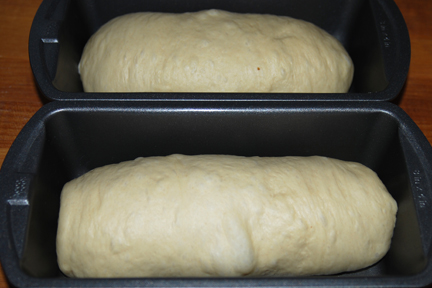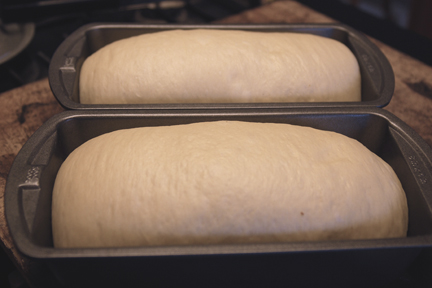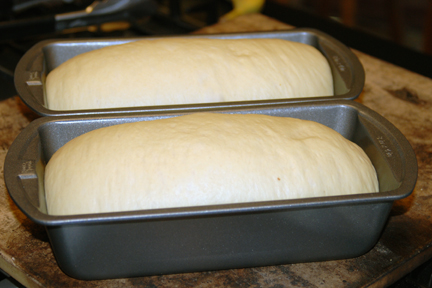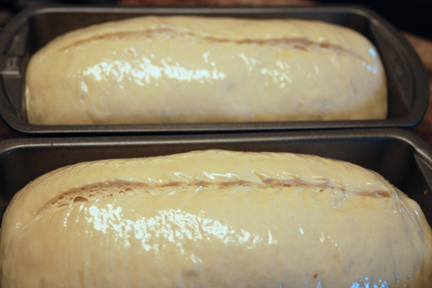
ITJB Vienna Bread
When I saw the strong proofing OWS was getting from his attempts at baking the Vienna Bread from Inside the Jewish Bakery. I baked this as a tester a long time ago but this is the now released version so I thought I’d give it a whirl. It's a fast rising enriched dough that just takes a few hours to complete.
The first thing I noticed is that the volume amounts an gram measurements don’t line up just right for me. The flour I scoop and level weighs 135g per cup. The recipe calls for 4-1/3 Cups. In my kitchen that would be 584 grams where the gram number is 620g. The oil is 2 T at 3.0 grams. I measured over 3 T of oil to be 30 grams. I didn’t go down item by item to see how they all worked out, I figured these are really Norms recipes and he would have kept notes in percents, Cups and pounds/ounces. I chose to use the gram weights and ignore everything else.
Another variable I had to make a decision on was the dough temperature. The recipe calls for warm water. I figured if the water was 82F the dough would come out near 78F after adding a cold egg and the other room temperature ingredients. That worked out perfectly. My dough temp was 77F.
My standard bread flour is Gold Medal, Better For Bread in the bright yellow bag. I think it’s right around 12% protein. The recipe calls for bread flour so my BFB should be OK.
One other thing that caught my attention was the use of malt and sugar. I only added 1 heaping teaspoon of dry malt powder where as the recipe calls for 2 T of dry or liquid malt or 20 grams. 2 T seems like a lot for under 4 cups of flour.
I used my Kitchen Aid mixer for this 2.3 Lb batch. It took 10 full minutes to reach a semi smooth consistency and a decent window pane window. I think I could of continued a little longer and fully developed the dough in retrospect. After removing the dough and manually kneading it for a minute or so, I shaped it in a ball and returned it to the mixer bowl and put it in the proofer, set at 78F. The dough was at 78F and after the rise it was still just where I wanted it, 78F. It took just 1 hour to double as you can see. I divided and shaped it into 2-534g logs. The recipe calls for 510 g pieces but this is what the recipe gave me. I don’t think the additional 24 grams will cause any serious over flowing of the dough. But considering what OWS has been seeing, it’s worth considering.
I egg washed after slashing and baked for what turned out to be 30 minutes at 350F to get an internal of 205F. I’m a little surprised the top tore open so much but It looks nice. The crumb is soft and tight grained as would be expected. The crust has a little bit of crunch where the egg wash came in contact with the sides of the pan. Sugar is caramelized slightly. I followed the directions pretty near right like the recipe called for, except for holding a little malt back. Looks OK to me and tastes great. This would be a great French Toast. Actually I almost made rolls out of half the dough and stuffed them with stewed onions. The girls loved this bread.
NOTE TO OWS: The only thing I am aware of that I did differently than you did is change the flour and held a stable dough temperature so I could judge the oven spring fairly. The spring seemed about right to me. Oh, and the malt may have been lower.
Eric

No collapsing here. Just a great enriched dough loaf.


After 8 minutes the dough looks about there. Total mix/kneading was 10 minutes

I would call this the right size pan for 534 grams of dough. 8.5X4.5 inches

Finishing proof at 78F at one hour.

Divided and shaped

Back in the 78F proofer for another hour.

Proofed to just over the top of the pans. Looks good.

Better lighting, proofed.

Egg wash and slash.

They look pretty good to me here.

Not overly expanded. Just right. They didn't collapse after cooling


Comments
Thank you for the parallel bake that I can compare to. I too have been using the gram weights provided and ignoring the rest, even to the extent that I did not even notice the apparent "discrepancies" you point out. Also, I've been using the full amounts of malt and sugar, as I always try to bake a new recipe exactly as prescribed first. The difference between our bakes that stands out most to me, aside from the malt you held back (and the flour differences), is the degree to which I have developed my doughs. I've definitely taken my dough development farther than you did here. I notice too that we both ended up with slightly more dough than the recipe proposes; you more so than I. I have been getting about 517-520 gram loaves at the time of the divide.
I regret that I did not take more temperatures, especially given the results, because I think there might be a clue there too. I too used 78F water, but my egg had been out of the refrigerator for about 45 minutes, and with a longer mix I suspect I ended up with a final dough temperature that was three or four degrees higher than yours going into bulk fermentation. I also proofed in a dough bucket in the coolish kitchen since I don't have a fancy new Brod & Taylor proofer (yet, but Christmas is coming so there is still hope!). Again I regret not taking more temperatures, as I'd like to know how my dough temperature compared to yours at time of shaping.
That's a very nice bake Eric, and I really do thank you for settling the issue of pan size and dough volume. Your bake proves (to me at least) that the 8 1/2 " by 4 1/2" pan prescribed for these loaves is not just adequate, but proper, and produces results that are more than simply "satisfactory". When I bake this tonight I will take more pictues, and also more temperatures as I proceed so I can compare more directly to your baseline example here.
OldWoodenSpoon
Post Script: I just saw a post on my own blog by Juergen Krauss asking me if I baked on a stone. I re-read your post and you don't mention if you did or not. Did you? Juergen mentions that he has experienced some funny results baking pan breads on stones.
Thanks for you comment OWS. The two of us beating this recipe to death is a labor of love isn't it? It's very good bread and "someone has to do it". Lol
I do on occasion bake pan breads on a stone but I always buffer the heat with a baking sheet below the pan. That's the way most commercial artisan bakeries do it. You will see a sheet pan with 4 or 6 pans of breads sitting on it going i n the deck oven. For me that only happens when I plan on baking a hearth bread after the pans or the other way around.
You know for this bread I really think All Purpose flour would give a softer crumb. Not that it's not soft now but softer. Honestly I don't have all that much experience with this kind of bread. Let me tell you though, I'm really looking forward to French bread tomorrow morning. That's going to be deeeelicious made custard like, like I do it.
These parallel bakes are fun. Got any other suggestions we can do from the new book?
Eric
Hi Eric, OldWoodenSpoon,
I tried the Black Bread - it went perfectly up to the baking.
I need to find a baking profile that works in my oven.
I might return to it next weekend.
Not sure if you want to join the "dark side";-)
Juergen
What was your issue with the baking profile?
Eric
Hi Eric,
I followed the instructions from the book meticulously - it is quite an unusual process. I had a thermometer in my oven to verify the temperatures, Yet the loaf came out half-cooked.
We had a discussion about my oven in my early TFL days - you migh remember.
My thought is that my oven takes on the lower temperature too quickly.
Stan says that the crumb looks terrific near the top crust - even there it's uncerckooked.
I cut into trhe loaf 36 hours after the bake.
My idea is to lower the temperature step by step mimicking a brick oven, kind of.
This bread has amazing potential - I wish you could smell it.
Juergen
Juergen,
Ahh, I see of what you write. Yes this is a common dilemma in these types of breads. The expert in this area is of course, Andy. He and I were experimenting with the Horst Bandel from Hamelman a couple years ago. I have tried all kinds of things to get these to cook evenly. It is more like an English pudding process if you are trying to get that kind of waxy solid crumb or internal structure. I do love the flavor of 100% dark rye done this way.
I have some ideas to start with. First I think the bottom looks like it didn't get the heat properly and was compressed. I would bake it in a pan on a stone, covered, for 11-16 hours at low heat. Start hot and let it fall to 220F. I've had luck baking in a pan of water to prevent the sides from getting tough and hard. Low and slow to get the Mallard effect that turns the rye dark and soulfully delicious.
Eric
Thank you, Eric,
I have to have another word with my oven ...
I just studied Andy's latest post and his 3-stage Auermann process looks a bit similar to the process for "Black Bread".
I'll compare the two this evening.
So far I can say that using a scald as part of the build-process really unlocks amazing flavors in the rye. I'll be on the case.
Horst Bandel's Pumpernickel is on my ToDo list since I read the recipe - I wait for that lonely weekend when I can just sit in front of the oven turning down the dial very slowly while getting drunk from the rye smells ...
Juergen
and you are correct, someone has to do it. Why not us? :) French toast eh? Gotta do something with all these test bakes. I think I feel another parallel effort coming on. I don't do the custard style though. I am actually mildly allergic to egg (causes skin reactions) so I always do a minimalist coating instead. It's what I was raised on, so it is familiar, and "right" to me.
You mention All Purpose flour and the softer crumb... You are certainly right about the AP flour, although I'm not sure getting the crumb any softer would be a good thing. In his comment on my first bake Andy (ananda) posted this link to a Stanley Cauvain book "Baking Problems Solved" that speaks directly to my issue and says:
For this reason I don't expect to get this bread totally right until I get some true All Purpose flour not over about 11.7% protein. Stan commented that I should get good results at 12%, but I suspect that at the degree of development I've gone to so far, 12% is still too strong. In the short run though, I suspect I can get closer to good results, and maybe even close enough, by not developing the dough as completely. Your windowpane picture and your later comment:
leads me to think my highly developed (and too strong) dough is retaining too much gas, and thereby weakening the structure of the loaf, and elevating the rise so high the foundation cannot hold it up. These pieces and the Cauvain reference seem to fit together. This is something I can test without waiting until I find a different flour, and I shall do that tonight.
Thanks, Eric, for letting me soak up so much bandwidth on your blog here today, and especially for helping me solidify my next test step for this bread. Like you said, somebody has to do it! In the mean time I'm also going to start a "fast" rye sour based on the ITJB formula so I can follow Juergen over onto the Dark Side. Maybe by next weekend I will be able to try the Black Bread recipe.
Too much fun!
OldWoodenSpoon
and my doubts that the recipe was right I tried it as well. My raw loaf weight was also 520 g. I didn't let it proof all the way to the top of the pans, but it turned out beautifully anyway. I used grams, too, but my experience w/ other recipe books has been that measurements usually are rounded to the nearest full whatever-it-is. Otherwise, where in a purely metric recipe you would have something like 150 g sugar you would get something like 147 g, or instead of 16 oz you'd have 14.5. It just reads weird, I guess.
My guess, OWS, is that the two differences in your method is the way you develop the dough and the tiles in the oven? Otherwise, thanks for pushing me to start baking w/ this book...!!! :)
Thanks for sharing. The pix are worth a thousand words each! The mixing bowl fits in the proofer; great idea, I ordered mine today (the B&T proofer not the mixing bowl). Couldn't wait for Xmas. Friction factor vs. time in mixer is something I've finally got around to keeping notes on.
Did you decide you were going share the bread with the girls, before you decided to bake it? :-)
Again thanks for sharing; what's next?
Jim
an interesting post so far. Eric, your Vienna is exactly as it should be, glad you like the finished product.
weight and volume mismatches are a huge problem, which is why virtually anyone who's serious about baking recommends baking by weight .
the weight/volumes in the book were taken from the USDA nutritional database; we reprinted our conversions in the Unpublished Chapters section of www.insidethejewishbakery.com. obviously, those ratios are going to vary, especially for powdered ingredients, depending degree of compaction, humidity, measuring technique (i.e., do you have air pockets in that cup of flour?), etc.
obviously, we couldn't be all things to all people, but we did try to be as consistent as possible within those limitations.
Stan
Szeretem a blogot! Gratulálok a szép kenyérhez! Nézz be hozzám.
http://www.flickr.com/photos/67544166@N06/sets/72157627546460607/
Nagyon köszönöm a kedves szavakat. Én már évek óta élvezzük a blog egy ideig. Remélem, el tudod olvasni ezt, és mondja el, hogyan elérni ilyen szép részletesen a kenyér.
Eric
Thank you so much for your kind words. I have been enjoying your blog for some time. I hope you can read this and tell us how you accomplish such beautiful detail in your breads.
Eric